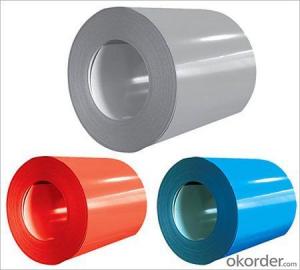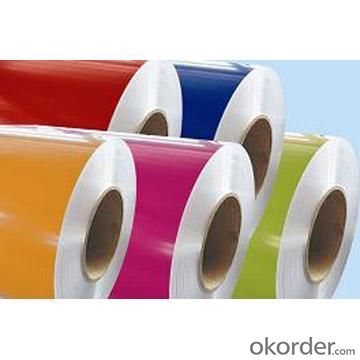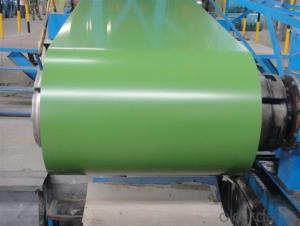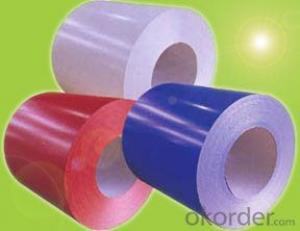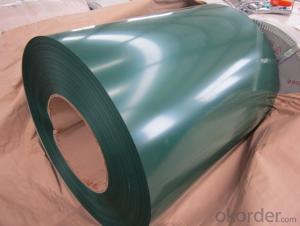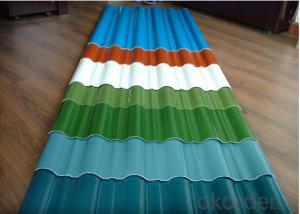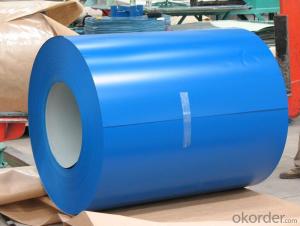HIGH QUALITY Pre-painted steel coil FOR YOU
- Loading Port:
- China main port
- Payment Terms:
- TT OR LC
- Min Order Qty:
- 50 m.t.
- Supply Capability:
- 1000 m.t./month
OKorder Service Pledge
OKorder Financial Service
You Might Also Like
Steel Specification:
Thickness: 0.2-3.0mm
Width: 600-1500mm
Tolerance for thickness,width,flatness and so on conform to the requirements of JIS G3302 or ASTM A653M/924M
Coil ID can be either 508mm or 610mm, maximum coil OD is 2000mm
The speicfication of ASTM Such as A653m,A924 M and so on have been updated to the latest revisions
Zinc Coating Weight Symbol | AZ/Z 06 | AZ/Z 08 | AZ/Z 13 | AZ/Z 12 | AZ/Z 18 | AZ/Z 20 | AZ/Z 22 | AZ/Z 26 | AZ/Z 27 |
Zinc Coating Thickness (mm) | 0.013 | 0.017 | 0.021 | 0.026 | 0.034 | 0.040 | 0.043 | 0.049 | 0.054 |
Weight g/㎡ (both sides) | 90 | 120 | 125 | 183 | 244 | 285 | 305 | 345 | 381 |
ASTM A 525 | G-30 | G-40 | G-60 | G-90 | G-115 |
- Q: How are steel coils used in the production of construction machinery?
- Steel coils are used in the production of construction machinery as they provide the raw material needed for manufacturing various components, such as frames, beams, and structural elements. These coils are processed and shaped into the desired forms, ensuring the machinery's durability, strength, and stability.
- Q: How do steel coils compare to other types of metal coils?
- Steel coils are highly regarded for their exceptional strength and durability, making them superior to other types of metal coils. Steel is known for its high tensile strength, allowing it to withstand heavy loads and resist deformation. This makes steel coils ideal for applications that require a high level of structural integrity, such as in the construction and automotive industries. In addition to their strength, steel coils also offer excellent corrosion resistance. Various protective layers, such as zinc or paint, can be applied to steel to prevent rusting and ensure longevity. This makes steel coils suitable for outdoor and marine environments where exposure to moisture and harsh weather conditions is common. Furthermore, steel coils have a diverse range of mechanical properties that can be customized through different manufacturing processes. This allows for the production of steel coils with specific characteristics, including high ductility, heat resistance, or electrical conductivity, to meet the requirements of various industries. When compared to other metal coils, such as aluminum or copper, steel coils often have a lower cost. Steel is one of the most economical metals available, and its abundance in nature contributes to its affordability. This makes steel coils a cost-effective choice for many applications, especially when large quantities are required. Overall, steel coils are distinguished by their exceptional strength, durability, corrosion resistance, versatility, and affordability. These qualities make steel coils the preferred choice for a wide range of industries, including construction, manufacturing, transportation, and energy.
- Q: How are steel coils used in the automotive stamping industry?
- Steel coils are used in the automotive stamping industry to provide a continuous supply of flat steel sheets that are then fed into stamping machines. These coils are unrolled, straightened, and then fed through the stamping presses to create various automotive parts, such as body panels, chassis components, and other structural parts. The use of steel coils ensures efficiency, precision, and a consistent quality in the production of automotive parts.
- Q: How are steel coils inspected for paint adhesion?
- Steel coils are inspected for paint adhesion using various methods and techniques. One common method is the tape test, where a strip of adhesive tape is pressed onto the painted surface and then quickly pulled off. The tape's adhesion to the paint is then assessed by examining the amount of paint that is removed from the surface. If the paint adheres well to the steel, only a small amount of paint will be lifted off by the tape. Another method used is the crosshatch adhesion test. In this test, a series of parallel cuts are made on the painted surface using a sharp blade, creating a crosshatch pattern. A piece of adhesive tape is then applied over the cuts and quickly pulled off. The amount of paint that is removed from the crosshatched area is evaluated to determine the paint adhesion. Additionally, a visual inspection is often conducted to assess the overall appearance and adhesion of the paint. Inspectors look for any signs of cracking, peeling, or bubbling of the paint, which could indicate poor adhesion. They also check for any areas where the paint may have chipped or flaked off. Furthermore, various laboratory tests can be performed to evaluate the paint adhesion on steel coils. These tests may include techniques such as the pull-off test, where a specialized device is used to measure the force required to pull off a small section of the paint from the surface. Other tests may involve subjecting the painted surface to extreme temperature or humidity conditions to assess how well the paint holds up under different environmental factors. Overall, a combination of visual inspections, tape tests, crosshatch adhesion tests, and laboratory tests are used to thoroughly inspect steel coils for paint adhesion. These tests help ensure that the paint adheres properly to the steel surface, providing a durable and long-lasting finish.
- Q: What's the difference between hot rolled coil and hot-rolled carbon thin steel coil?
- Hot rolled coil is used for continuous casting slab or as raw material, after reheating furnace heating, descaling into the roughing mill of high pressure water, roughing material by cutting head, tail, and then enter the finishing mill, the implementation of the computer controlled rolling, after finishing through the laminar cooling (computer controlled cooling rate and coiling) reel, a straight hair volume. Hair straightenerrollhead, tail tongue shapeand thefishtail shape, thickness, width of poor accuracy, edgehaswavy, folding, tower and other defects. The volume is heavy. (general management industry likes to use. )
- Q: What are the safety precautions to be followed while handling steel coils?
- When handling steel coils, there are several safety precautions that should be followed. These include wearing appropriate personal protective equipment, such as gloves and safety glasses, to protect against cuts, abrasions, and eye injuries. It is important to use proper lifting techniques and equipment to prevent strains or back injuries. Steel coils should be securely stacked and stored to prevent them from falling or rolling, and caution should be exercised when moving or transporting them to avoid accidents. Additionally, workers should be trained on the safe handling and storage procedures specific to steel coils to minimize any potential hazards.
- Q: Can anyone tell me what that means. I have seen it on knife blades an such. I am assuming it's a formula for the strength of the metal. who does that scale work, and please keep it simple.
- 440 is an AISI (American Iron and Steel Institute) material specification. It specifies the precise quantities of carbon and other elements present in the alloy. Here are the constituents of AISI 440 steel: Carbon - 0.6 to 0.75% Chromium - 16 to 18% Manganese - less than 1% Molybdenum - less than 0.75% Phosphorus - less than 0.04% Silicon - less than 1% Sulfur - less than 0.03% Iron makes up the remainder. AISI 440 is a heat-treatable, precipitation-hardening stainless steel.
- Q: The steel is orangish in colour and is mostly made of copper
- Steel is an alloy of iron and carbon and optionally one or more of numerous other materials. Copper is normally not used, except sometimes in small percentages. Steel is never yellow or orange in color. Reactivity of steel depends on the materials it is alloyed with. Chromium and nickel with steel make stainless steel, which is much less prone to reactive than iron. .
- Q: I just bought a dpms ar15 and it says if I shoot steel cases (laquer coated) or foreign ammo it voids the warranty. But before I knew this I bought 200 rounds of Russian steel cased anmo. Think I should just shoot there two hundred and not buy anymore? Some people say all they shoot is steel cased ammo and have no problemAny advice is appreciated
- steel case does not cause additional wear to the gun's chamber when compared to brass case. many tests has been done and precise measurements taken, this myth has been proven false. lacquer coating can cause issues because it can melt and cool, and cause jams. this is easily remedied with a chamber brush and some solvent.. However, steel jacket causes problems. Steel is harder than copper, it does not deform as easily so it causes more wear to the barrel as compared to copper or brass. The rate is around 10-25%, inreasing if you hoot rapidly instead of slowly. more shooting = hotter barrel = faster wear. It's the same with copper/brass jackets, but steel jacketed always wears more than softer metals. TulAmmo (or tula) is particular is so cheaply made they don't have enough copper/brass wash on the bullet to survive firing, after a few inches of travel it's steel on steel contact in the bore and it can ruin a gun barrel very quickly. But... there is one exception. if your gun comes with a chrome-lined bore that is standard for most AR's , shoot all the cheap junk you can buy. chrome-lined steel is 2X as hard as plain steel. crappy tula .223 will not cause more harm to a chrome-lined bore more than brass or copper jacketed bullets.
- Q: How are steel coils used in the appliance industry?
- Steel coils are used in the appliance industry for a variety of purposes such as manufacturing parts, components, and frames for appliances like refrigerators, washing machines, and ovens. The coils are processed and shaped into specific forms to provide strength, durability, and stability to the appliances.
Send your message to us
HIGH QUALITY Pre-painted steel coil FOR YOU
- Loading Port:
- China main port
- Payment Terms:
- TT OR LC
- Min Order Qty:
- 50 m.t.
- Supply Capability:
- 1000 m.t./month
OKorder Service Pledge
OKorder Financial Service
Similar products
Hot products
Hot Searches
Related keywords
